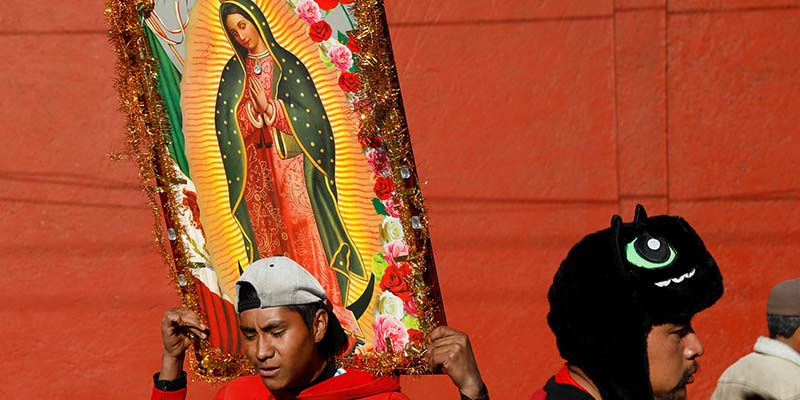The canonization of the child martyrs reveals the great task of the religious in the evangelization of Mexico, and the pre-Hispanic faith of the Mesoamerican ethnic groups.
-text Ruben Rodriguez
Mexican Society of Ecclesiastical History and vice-postulator of the cause of the Children Martyrs of Tlaxcala in Mexico.
Mexico is an exciting reality. Born of two very noble roots, it is at the head of that great portion of humanity that is Latin America, called by Popes John Paul II and John Paul II, "Latin America," and "Latin America," "Latin America," "Latin America," "Latin America," "Latin America," "Latin America," and "Latin America. Benedict XVI "the continent of hope". Its first roots are the multiple Mesoamerican ethnic groups that, settled in our territory for more than 10,000 years, dazzled the conquerors themselves.
Hernán Cortés, in his First Letter of Relation to Charles Vhe says: "...Surely God our Lord would be well served, if... these people were introduced and instructed in our most holy Catholic faith and commuted the devotion, faith and hope that they have in these idols of theirs, in the divine power of God; because it is certain that if with so much faith and fervor and diligence they served God, they would perform many miracles.".
Its second root, the Spanish, was so strong in the 16th century that it created the Spanish empire. "where the sun never set". Those Spaniards, upon arriving in Mexico, fell in love with it, to the point that they called it after their own homeland: New Spain.
Both roots had a dramatically traumatic encounter, which led them to seek the extermination of the other and culminated in the unfortunate destruction of the Great Tenochtitlan, one of the most beautiful cities in history, in 1521.
But ten years later, in 1531, Saint Mary of Guadalupe reconciled them, made them aware that they were one nation, and led them to build a new country, which became the most important in the Americas in the sixteenth to eighteenth centuries.
Much has been written, and with good reason, about the great work done by the religious orders in the evangelization of America, especially the Franciscans, Dominicans and Augustinians. But little is still known about the deep and sincere pre-Hispanic faith that those ethnic groups lived, embodied in the venerated Huehuaetlamanitilizti (Tradition of the Elders), passed down by the Tlamatini o Sabios (the sage: a light, a fire, a thick fire that does not smoke...). They lived that faith with great sacrifices, even of their own lives, as Fray Bernardino de Sahagún describes with admiration: "As far as religion and the culture of their gods are concerned, I do not believe that there have been in the world idolaters so reverent of their gods, nor so much at their expense, as these of New Spain; neither the Jews, nor any other nation had such a heavy yoke and so many ceremonies as these natives have taken for many years..."
The Virgin of Guadalupe
Their faith was full of semina VerbiWhen they heard the tender words of St. Mary of Guadalupe, they understood that she had come to give them their full fulfillment: "In nicenquizca cemicac Ichpochtli Santa Maria (the I-perfect-forever-Virgin Holy Mary), in Inantzin in huel nelli Teotl Dios (the-His-Venerable-Mother-of-the-Very-True-God God God), in Ipalnemohuani (the Living-Cause-of-All-Life), in Teyocoyani (the Creator-of-the-People), in Tloque Nahuaque (the Owner-of-the-Joint Owner-of-the-Round), in Ilhuicahua (the Owner-of-the-Heaven), in Tlalticpaque (the Owner-of-above-Earth)". They no longer hesitated and converted en masse and forever. And they have kept that Catholic faith for five centuries, always in the midst of tyrannies, revolutions and persecutions.
"And you, dwellers of this New Spain, rejoice to have had such blessed martyrs as these children were, and with greater reason those of this city of Tlaxcalan, which was their principal cradle.". Thus testifies Fray Toribio de Benavente (affectionately called Motolinía -the poor boy - by the indigenous people), in their Memoriales o Libro de las Cosas de la Nueva España y de los Naturales dellaThe impact that the indigenous children caused the friars by their careful education, their strong virtues and their intelligence. These children became their best collaborators in the evangelizing task.
The Franciscans arrived in New Spain on May 13, 1524. It is remarkable that, very soon after, these children catechized by them had the maturity to receive the crown of martyrdom: Cristobal in 1527 and Antonio and Juan in 1529, as attested in 1541 by the same Motolinía in its History of the Indians of New Spain. Historian Salvador Abascal wrote in 1990: "Are it perhaps Cristobalito, Antonio and Juan who attract for Mexico, without even being able to sense it... the supreme award of the peerless Apparitions of Tepeyac?".
Universal transcendence
Twenty-five years after their beatification, when the Church set them as models of holiness for the noble people of Tlaxcala, she now proposes them for all humanity. A model of full actuality: they are lay people, just like 99.9 % of the 1.2 billion Catholics; they are Americans, like half of the Catholics today; they are indigenous people, who will help us to revalue so many ethnic groups that have been relegated and even despised; they are children who will help us to revalue those great gifts that God continues to send us: our children.







